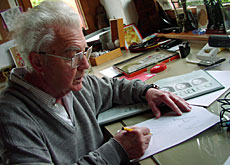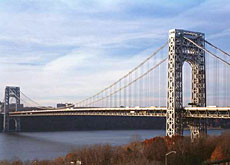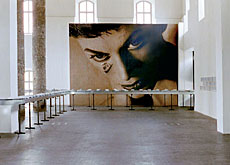Swiss designer stamps his mark

From the Swiss Post Office emblem to the lettering on signs at Charles de Gaulle airport in Paris, the fonts created by Swiss designer, Adrian Frutiger, are instantly recognisable.
swissinfo paid a visit to one of the most famous creators of fonts at his workshop near the Swiss capital, Bern.
“A Life Devoted To Fonts” is the title of Frutiger’s recently published autobiography.
Over a career spanning nearly six decades, Frutiger has designed over 30 fonts and won many awards for his work as a graphic designer.
Frutiger – best known for creating the Univers typeface family – began his career in 1944 as a printing house apprentice in Interlaken, but spent his formative years as a graphic designer in Paris.
He returned to Switzerland in 1994, and his workshop is full of signs of a lifetime spent among letters and characters.
After a spell in Zurich at a school of arts and crafts in the early 1950s, the Swiss designer went on to establish a name for himself at Paris-based typesetters, Deberny & Peignot.
Establishing his name
While in France, he developed a revolutionary new form of typeface, adapting classical roman characters and reinterpreting them in a modern way.
“I developed a system in which all the strokes of letters had the same look, the same height and a systematic gradation of bold type,” Frutiger told swissinfo.
The result was the phenomenally successful Univers font, which was quickly adopted by printing houses and advertising agencies around the world after it was introduced in 1957.
“Historically, the appearance of Univers caused a sensation,” Frutiger recalls.
Along with the Helvetica font – created in 1957 by Max Miedinger – Univers formed part of the so-called Swiss style of international fonts, which marked the heyday of typeface creation in Switzerland.
Flushed with success, Frutiger later established his own design studio with two other Swiss designers, Bruno Pfäffli and André Gürtler.
Technology
Frutiger’s autobiography spans the decades between the early printing systems of the 1950s and the digital typesetting revolution of the 1990s.
The septuagenarian still believes a designer can work best with pencil and paper, but has no objection to the use of computers to create and refine new fonts.
“Computer screens today have sufficient definition to bring out even the smallest details of a good font,” says Frutiger.
“[But] I have always refused to substitute my hand, a marvellous instrument, for a computer,” he continues, adding that a font can only achieve a harmonious shape if it is created by hand.
swissinfo, Andrea Tognina (translation: Isobel Johnson)
Born in Unterseen, canton Bern, in 1928, Frutiger served as a printing press apprentice in Interlaken from 1944 to 1948.
After further study in Zurich, he was offered a job at Deberny & Peignot in Paris in 1952, where he created the Univers font.
He opened his own studio in Paris in 1961 with two other Swiss, Bruno Pfäffli and André Gürtler.
Frutiger returned to Switzerland in 1994.
His fonts have been used for Swiss street signs and for the Swiss Post Office.

In compliance with the JTI standards
More: SWI swissinfo.ch certified by the Journalism Trust Initiative











You can find an overview of ongoing debates with our journalists here . Please join us!
If you want to start a conversation about a topic raised in this article or want to report factual errors, email us at english@swissinfo.ch.